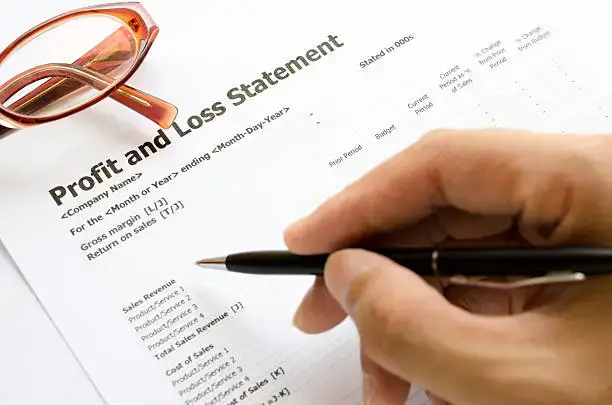Last Updated on March 14, 2023

In the world of business, understanding the financial health of a company is essential for making informed decisions and achieving success. One of the most important financial statements that provide insight into a company’s performance is the profit and loss statement (P&L). A P&L statement is a summary of a company’s revenues, costs, and expenses over a specific period, typically a month, quarter, or year. It is a crucial tool for business owners, managers, and investors to assess a company’s financial performance, track trends, and identify potential areas for improvement.
In this article, we will discuss what a profit and loss statement is, its components, the importance of a P&L statement, how to prepare and interpret it, and its limitations. By the end of this article, you will have a comprehensive understanding of how to use a profit and loss statement to analyze a company’s financial health and make informed decisions.
What is a Profit and Loss Statement?
To understand what a Profit and Loss Statement (P&L) is, it is important to define its components and the types of statements that exist.
Firstly, a P&L statement is a financial document that summarizes a company’s revenues, costs, and expenses over a specific period. It provides a snapshot of the company’s financial performance and shows whether the business is making a profit or a loss.
The components of a P&L statement include:
1. Revenue:
This is the income generated by the company through the sale of goods or services.
2. Cost of Goods Sold (COGS):
This refers to the cost of producing or acquiring the products or services sold.
3. Gross Profit:
This is the difference between revenue and COGS.
4. Operating Expenses:
These are expenses incurred by the business in the normal course of operations, such as salaries, rent, utilities, and marketing costs.
5. Operating Income:
This is the income earned by the company after deducting operating expenses from gross profit.
6. Non-Operating Items:
These are income and expenses that are not related to the normal course of business operations, such as interest income, dividends received, and gains or losses from investments.
7. Net Income:
This is the final result of deducting all expenses, including non-operating items, from the revenue.
Secondly, there are two types of P&L statements:
- Single-Step P&L Statement: This is a simple P&L statement that calculates the total revenues and deducts the total expenses to determine net income.
- Multi-Step P&L Statement: This statement provides more detail by breaking down the revenues and expenses into various categories. This type of statement is useful for larger companies with more complex operations.
Overall, understanding the components and types of P&L statements is essential to comprehend the financial performance of a company. It helps managers, investors, and other stakeholders make informed decisions about the business.
Importance of a P&L Statement
When running a business, it’s essential to understand how your company is performing financially. In this section, we’ll explore the importance of a profit and loss statement and how it can help you manage your business more effectively.
1. Helps with Business Decision Making
The profit and loss (P&L) statement is a critical tool for making informed business decisions. By providing a clear and detailed picture of a company’s financial performance, it enables business owners and managers to make strategic decisions that drive growth and profitability. The P&L statement highlights areas where a company is performing well and areas where it’s falling short, enabling decision-makers to allocate resources and make changes to improve performance. It also helps identify potential risks and opportunities, allowing businesses to take proactive measures to mitigate risks and capitalize on opportunities.
2. Helps with Financial Planning
In business, financial planning is critical to ensuring that the company is on track to meet its goals and objectives. The Profit and Loss (P&L) Statement plays a crucial role in financial planning by providing a comprehensive overview of a company’s financial performance. By analyzing the P&L statement, business owners and managers can identify trends, such as revenue growth or expense reduction, and use this information to plan for the future. They can also forecast future revenue and expenses and adjust their plans accordingly.
This helps businesses manage their finances more effectively, optimize cash flow, and make informed decisions about investments, acquisitions, or other strategic initiatives. By leveraging the insights gained from a P&L statement, businesses can better plan for the future and achieve long-term success.
3. Helps with Tracking Business Performance
Tracking business performance is critical to ensuring that a company is meeting its goals and objectives. The Profit and Loss (P&L) Statement is a valuable tool for tracking business performance as it provides a detailed breakdown of a company’s revenue, costs, and expenses over a specific period. By regularly analyzing the P&L statement, business owners and managers can track how their company is performing, identify areas of strength and weakness, and adjust their strategies accordingly. They can also compare current performance to that of previous periods and industry benchmarks to gain insights into their competitive position.
Additionally, a P&L statement can help businesses identify opportunities for growth, such as expanding into new markets or investing in new products or services. By using a P&L statement to track business performance, companies can make data-driven decisions to optimize their operations and achieve long-term success.
4. Helps with Meeting Financial Goals
Every business has financial goals, whether it’s increasing revenue, reducing costs, or improving profitability. The Profit and Loss (P&L) Statement is a crucial tool for achieving these goals as it provides a detailed breakdown of a company’s financial performance. By analyzing the P&L statement, business owners and managers can identify areas where they can reduce costs, increase revenue, and improve profitability. They can set specific financial goals and use the P&L statement to track progress toward those goals.
This information helps businesses make informed decisions about how to allocate resources, such as investing in marketing or expanding their product line. With the help of a P&L statement, businesses can make informed decisions that enable them to achieve their financial goals and position themselves for long-term success.
How to Prepare a Profit and Loss Statement
Now that we have established the importance of the profit and loss (P&L) statement, let’s take a closer look at how to prepare one for your business.
The first step in preparing a P&L statement is to gather all the necessary financial information. This includes revenue figures, cost of goods sold, operating expenses, and any other expenses related to running the business.
Next, organize this information into appropriate categories, such as revenue, cost of goods sold, and operating expenses. It’s essential to ensure that all expenses are accurately recorded and categorized to provide a clear picture of your business’s financial health.
After categorizing the information, calculate your business’s gross profit, which is the revenue minus the cost of goods sold. This figure provides a high-level overview of your business’s profitability.
Finally, subtract operating expenses from the gross profit to calculate your business’s net profit. This figure represents the final amount that the business earns after all expenses have been paid.
It’s important to note that preparing a P&L statement can be complex, and it’s always best to seek the advice of a financial professional to ensure accuracy and completeness. However, with proper preparation and attention to detail, the P&L statement can be an invaluable tool for managing and growing your business.
Limitations of a Profit and Loss Statement
While the profit and loss (P&L) statement is a powerful tool for managing and analyzing a company’s financial performance, it’s important to acknowledge its limitations.
One limitation is that the P&L statement only reflects a specific period and may not provide a complete picture of a company’s financial health. For example, a company may experience a significant one-time expense that negatively impacts its net profit for a particular period, but may not reflect the business’s long-term profitability.
Additionally, the P&L statement does not account for non-financial factors that may impact a company’s performance, such as changes in customer preferences, industry trends, or regulatory changes.
Furthermore, the P&L statement does not provide information about a company’s cash flow or liquidity, which can be critical for assessing a business’s ability to pay debts and operate on a day-to-day basis.
Finally, while the P&L statement can identify areas where a company can reduce costs or increase revenue, it does not provide information about how to achieve those goals. Businesses need to take additional steps to develop and execute strategies to optimize their operations and financial performance.
In summary, while the P&L statement is a useful tool for managing and analyzing a company’s financial performance, it’s essential to consider its limitations and use it in conjunction with other financial and non-financial data to make informed decisions about your business’s future.
Conclusion
In conclusion, the Profit and Loss (P&L) statement is an essential financial tool that helps businesses track their financial performance, make informed decisions, and achieve their financial goals. By analyzing the P&L statement, business owners and managers can gain valuable insights into their company’s revenue and expenses, identify areas for improvement, and set specific financial targets.
While the P&L statement is a powerful tool, it’s important to acknowledge its limitations and use it in conjunction with other financial and non-financial data to make informed decisions about your business’s future. It’s also crucial to ensure that the P&L statement is accurate and complete and to seek the advice of financial professionals when necessary.
We recommend that businesses prepare a P&L statement regularly, such as monthly or quarterly, to track their financial performance and identify any trends or patterns. By doing so, they can make timely adjustments and optimize their operations to achieve their financial goals.
Overall, the profit and loss statement is a critical tool that can help businesses make informed decisions, achieve their financial goals, and position themselves for long-term success. With proper preparation, analysis, and attention to detail, businesses can use the P&L statement to unlock valuable insights into their financial performance and chart a course for growth and prosperity.
Before you go…
Hey, thank you for reading this blog to the end. I hope it was helpful. Let me tell you a little bit about Nicholas Idoko Technologies. We help businesses and companies build an online presence by developing web, mobile, desktop, and blockchain applications.
We also help aspiring software developers and programmers learn the skills they need to have a successful career. Take your first step to becoming a programming boss by joining our Learn To Code academy today!
Be sure to contact us if you need more information or have any questions! We are readily available.











